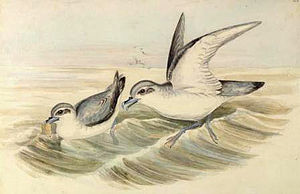Whale birds
| Whale birds | ||||||||
|---|---|---|---|---|---|---|---|---|

Fairy petrel ( Pachyptila turtur ) |
||||||||
| Systematics | ||||||||
|
||||||||
| Scientific name | ||||||||
| Pachyptila | ||||||||
| Illiger , 1811 |
The whale birds ( Pachyptila ), also called "duck petrels", "kingfishers" or "firebirds", are a genus of the petrel family (Procellariidae), which are found in the Antarctic waters. With a body length of 25.4 to 28 cm and a wing span of 40.7 to 45.7 cm, they are among the rather small representatives of this family. They differ from the other petrels by their inconspicuous plumage and their beak as well as by their flight and feeding style.
features
The individual species of this genus are distinguished mainly by their beaks. Basically, beaks of the species of this genus look triangular when viewed from above: They are very broad at the base of the beak and taper to a point. All species have lamellae on the upper beak sheath with which they can filter plankton out of the water. The size of the beak varies considerably between species, which indicates that each species is different in the way they feed. In flight, the individual species can hardly be distinguished from one another, as their plumage is similar. They are all colored pale blue-gray on the upper side, while the shoulder edge, shoulder feathers and outer hand wings are black. The underside and lower wings are white, the tail is wedge-shaped and the beak is bluish gray. The feet are blue in color.
Way of life
They can often be seen in swarms when they fly in fast, zigzag flights close to the water. The calls of the individual whale bird species are very similar, with males and females differing greatly in all species. Their way of life is very similar. They come ashore only at breeding season and usually nest on islands far offshore with thick grass or forest. Their diet consists mainly of small fish and crustaceans, which they ingest from the surface of the water. So far it is not known exactly at what age they breed for the first time. Most species nest in holes they have dug themselves. The clutch consists of an egg. This has a smooth, whitish shell surface. The egg is incubated for a period of six to seven weeks. The chicks can fledge after seven to eight weeks.
Whale birds and people
As with numerous other breeding seabirds, the colonization of the whale bird breeding islands by humans has negatively influenced the population of the whale birds. The most important survival factors are the introduction of rats, house cats, pigs and other mammals, which eat the eggs, young and also adult birds.
Whale birds were occasionally classified as pests during the 20th century. In 1964, Belcher petrels were still allowed to be killed at any time in the Falkland Islands according to the Wild Animals and Birds Protection Ordinance , because it was assumed that the birds would damage sheep pastures by digging their nesting burrows. In the Falkland Islands, where the Belcher petrel was once very numerous, this species only breeds on seven small islets off the coast of the main islands.
Internal system
The genus includes the following six species:
- Great duck petrel ( Pachyptila vittata ). The beak of this species is steel-gray above and bluish-yellow below.
- Small duck petrel ( Pachyptila salvini ). Here the beak is bluish-gray above and below.
- Pigeon petrel ( Pachyptila desolata ), which breeds on the Antarctic Peninsula and on Kerguelen and Heard , among other places .
- Belcher petrel , also thin-billed whale bird ( Pachyptila belcheri ). The Belcher petrel is characterized by a long, very narrow beak.
- Fairy petrel ( Pachyptila turtur )
- Thick-billed petrel ( Pachyptila crassirostris ), which differs from the other whale birds by a thickened beak plate.
supporting documents
literature
- Hadoram Shirihai: A Complete Guide to Antarctic Wildlife - The Birds and Marine Mammals of the Antarctic Continent and Southern Ocean. Alula Press, Degerby 2002, ISBN 951-98947-0-5 .
- Robin and Anne Woods: Atlas of Breeding Birds of the Falkland Islands. Anthony Nelson, Shorpshire 1997, ISBN 0904614-60-3 .
